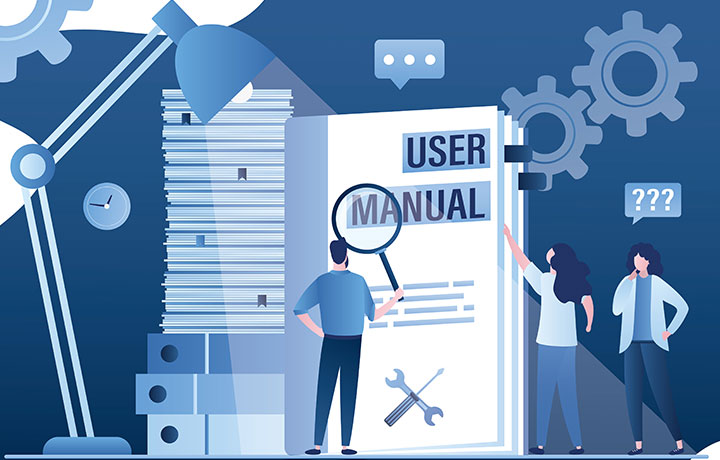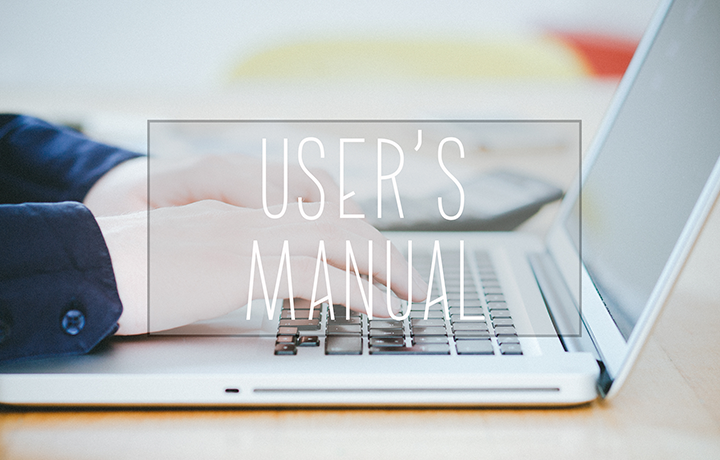
Hello! I am K, a consultant.
I usually handle manual creation and improvement projects for companies in the manufacturing and call center industries. This time, I will introduce the benefits of creating operational manuals, as well as key points for successfully creating manuals, using case studies from companies and tips I have learned from daily operations.
- Table of Contents
1. Three Benefits Gained from Creating Business Manuals

Have you ever felt like you understood the explanation about the work from your boss or seniors, but when you actually started the tasks, you found yourself wondering, "How should I do this?" Also, have you ever seen your colleagues working in their own ways and thought, "Which method is correct?" or "Wouldn't it be more efficient to have a unified approach?"
When faced with such issues, many of you may have thought, "I wish the manual was well-organized..." However, there are likely many companies that do not have the time to create operational manuals alongside their core business and are putting it off. In fact, among the clients who consult with us, there are many who are struggling with the situation of thinking, "I should create an operational manual, but I am overwhelmed with my core business."
As everyone is aware, unfortunately, business manuals cannot be created quickly. However! By taking the time to create them, you can achieve significant benefits. Specifically, what kind of benefits are there?
The first effect is improvement of business quality.
By organizing business procedures, you can gain an overview of the entire operation. This allows you to identify wasteful aspects and areas for improvement in the current operations, contributing to the enhancement of business quality.
In fact, we have often received feedback from clients stating that the greatest achievement was being able to take stock of their operations through the manual creation process. Not only does it clarify the operations, but it also allows for a review of the operations themselves during the process, which is a significant benefit of manual creation.
The second effect is standardization of work quality.
By organizing work procedures in a visible manner, it ensures that a consistent level of work results can be achieved regardless of who is in charge.
A common situation when business manuals are not established is that employees tend to compile points and tips for performing tasks individually in their notes. This leads to the personalization of tasks, making it impossible to share rules across the organization. Business manuals can be utilized as a platform to visualize these individual insights and know-how, and to return them to the organization.
The third effect is the efficiency of education.
Having operational manuals allows for efficient training of new members in a short amount of time. It also reduces the burden on trainers. Furthermore, it enables teaching the objectives and procedures of tasks without omissions, allowing for high-accuracy training.
The other day, a company contacted us in a panic, saying, "A veteran employee is about to retire, and we realized that none of the know-how has been documented. If this continues, our technology and know-how will be lost!" It is crucial to start organizing operational manuals early to ensure that the technology and know-how cultivated within the organization are reliably passed on to the next generation.
What do you think? I would be very happy if more people became interested in creating business manuals by understanding the benefits that can be gained.
However, it is dangerous to recklessly start creating business manuals just because you want to see results quickly. Next, we will introduce the key points for successfully creating business manuals.
Related Blog: Key Points for Creating Manuals to Achieve Business Standardization
This document introduces methods for optimal operation and implementation when creating manuals, as well as case studies from various companies.
Related Materials: Tips for Creating and Implementing Business Manuals from Professionals
2. Three Key Points for Successfully Creating Business Manuals

Based on customer experiences, our company believes that there are three key points to successfully creating operational manuals.
Point 1: Determine the purpose and scope of the business manual
When you start creating a business manual, the first step is to determine its purpose and scope. If you rush into creating a business manual without deciding on these aspects, you may end up with a manual that takes a long time to produce but is not used. For example, if the purpose is to transfer technology from veteran employees to younger employees, then naturally, the tasks handled by veteran employees should be the focus of the manual. If the goal is to visualize complex tasks and share them with the team, you should start with the most complicated and difficult tasks for the manual. Therefore, it is important to decide which tasks will be documented, who the target users of the manual are, and what you want to achieve by using the manual.
Point 2: Start with small-scale manual creation
Prioritize the tasks you want to document and start by creating a manual for one task. It is recommended to choose a generic task that can be applied to other tasks as well. If you create a large-scale manual from the beginning, it can be difficult if revisions are needed later. By starting small, you can verify what content should be included in the manual and what type of template is most suitable, allowing you to proceed with fewer setbacks. Please utilize the results of your verification in the creation of future task manuals.
In the case of a manufacturing client, we first tackled the manual for the product with the most general features, rather than the most popular product. By selecting the manual to work on first from the perspective of "Which manual can be expanded to more other products and services?", the introduction of manuals across the entire range of products and services becomes smoother.
Point 3: Decide on the administrator for the business manual
Even if you create a business manual, it is meaningless if it is not properly utilized. A common issue is that, although a manual is created, it fails to reflect the detailed procedures and flow of information that are updated daily, and before you know it, the content of the manual becomes inconsistent with reality and becomes obsolete.
To prevent such situations, let's designate a manager for the business manual from the creation stage. The manager does not necessarily need to be well-versed in each specific task. By appointing someone to consistently manage aspects related to the manual, such as how updates will be made, where and how the manual will be managed, and who will edit the manual, it can be properly updated in accordance with changes in operations, ensuring that the latest information reaches users, allowing for the continued use of a living business manual!
How did you find the three points to successfully create a business manual? Some of you may feel that it seems difficult to actually create one. In such cases, it might be a good idea to leave it to the experts at first. Next, I will briefly introduce some examples of companies we have supported.
[Related Blog] Six Points for Creating a Business Manual
This document clearly introduces five key points for creating a good manual. Please feel free to download and make use of it.
Related Materials: Five Key Points for a Good Manual
3. Case Studies and Effects of Business Manual Implementation

●Tokyu Livable, Inc.
Needs / Challenges
This company had a need to create a business manual to share the basic concepts and workflows of office and store rental brokerage operations. Additionally, they faced the challenge of work becoming dependent on specific individuals, resulting in a gap in skills and knowledge between veteran employees and those with less experience.
<Solutions>
We clarified the purpose and scope of the manual through interviews with new employees who will be the main users of the business manual, and created it while sharing the final image.
Customer Feedback
By creating a business manual, we were able to share the standard workflow and procedures with newly assigned employees, which was a significant achievement.
https://www.science.co.jp/case/tokyu_livable/manual/
●Mitsubishi Electric Corporation
<Needs / Challenges>
This company had a need to "efficiently promote human resource development within the organization by standardizing non-routine tasks into manuals."
<Solutions>
Among the various tasks, we first identified the procedures for one specific task and proceeded to create a manual. Additionally, we made efforts not only to create the manual but also to share the manual creation workflow with the client's internal working group.
Customer Testimonials
By standardizing the parts that relied on individual training, we were able to create a solid foundation for future training.
https://www.science.co.jp/case/mitsubishielectric/manual/
Our site also introduces many case studies from other companies. If you are interested, please refer to this link.
https://www.science.co.jp/case/
This document clearly introduces five key points for creating a good manual. Please feel free to download and make use of it.
Related Materials: Five Key Points for a Good Manual
4. Summary
This time, we introduced the effects of creating business manuals and key points for successful manual creation, along with examples from companies. How was it? Please make sure to keep these points in mind when creating your business manuals.
"That said, it is challenging to create operational manuals alongside regular business operations. If you are going to create them, you want to ensure that the operational manuals are definitely used." We recommend that companies with this mindset hire a professional.
By the way, we sometimes receive questions from customers such as, "Is it possible to create manuals for non-standard operations?" The answer is "YES"! Our company believes that creating manuals for non-standard operations is just as important as for standard operations.
Human Science has a proven track record of creating numerous manuals since 1985. We are truly a professional group in the field of business manual creation. We can consistently support you from organizing current issues to formulating improvement policies and creating customized manuals. If you have any difficulties in creating business manuals, please feel free to consult us.
https://www.science.co.jp/document/index.html
Feature 1: Extensive Manual Production Experience with Large and Global Companies
Human Science has a track record of producing manuals for 243 companies and 3,148 projects, primarily in the manufacturing and IT industries. We have had renowned companies such as "Docomo Technology Inc.", "Yahoo Inc.", and "Yamaha Corporation" as our clients.
Feature ②: Research and Analysis by Experienced Consultants - Output
The creation of business manuals is handled by our experienced consultants at Human Science. Our skilled consultants will propose clearer business manuals based on their extensive experience and the materials provided. Additionally, manual creation is possible even from the stage where no materials are available. The assigned consultant will conduct interviews and create the manuals.
Feature ③: Not only creating manuals, but also providing support for implementation
Human Science is responsible for the important phase of "implementation" after manual creation. For example, even after the manual is created, we will conduct updates and hold manual creation seminars. By implementing various measures, we approach the goal of ensuring that the manuals are established in the field.
Thank you for reading until the end.
I hope this blog serves as a helpful hint for creating business manuals.
Tips for Creating and Establishing Business Manuals

Related Services
- Services
- Business Manual Creation Services
- Services
- User Manual Creation Service
- Services
- Video Manual Creation Service
- Services
- Manual Translation Services








































































 Manual creation
Manual creation Director, Writer
Director, Writer In-house Support
In-house Support Video
Video Manual
Manual Manual Creation
Manual Creation One-Stop Service for Manual Creation
One-Stop Service for Manual Creation Manuals and Documents
Manuals and Documents



